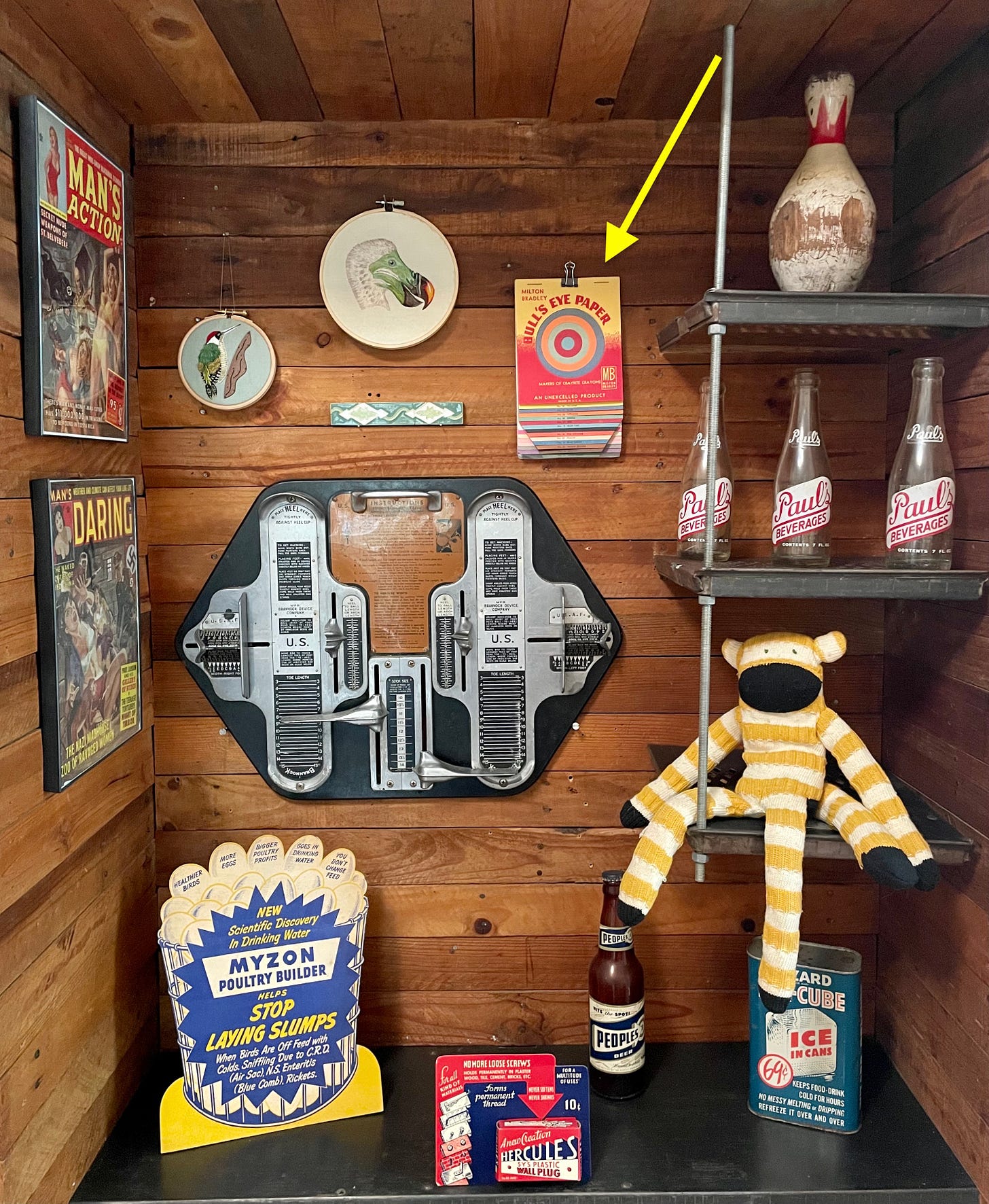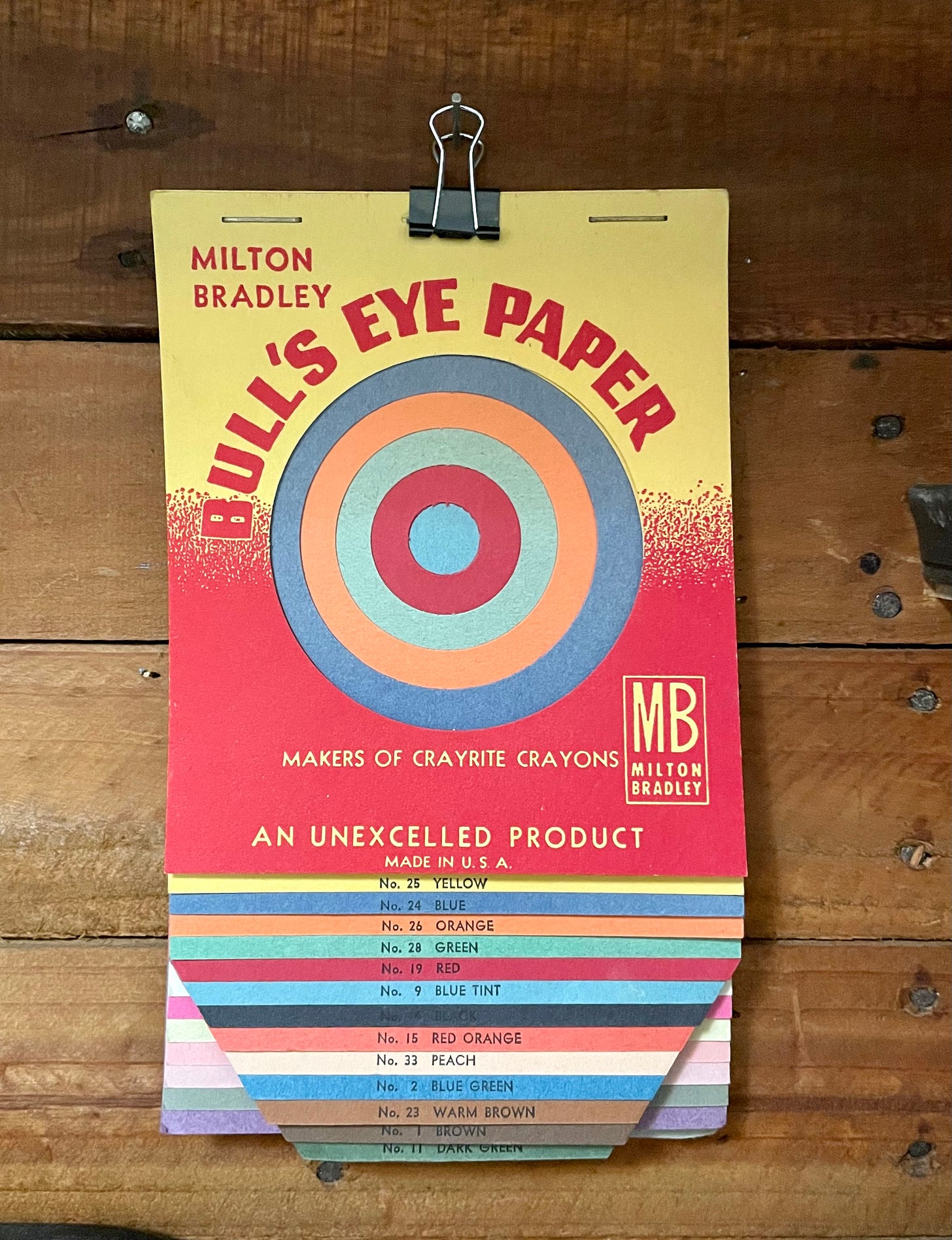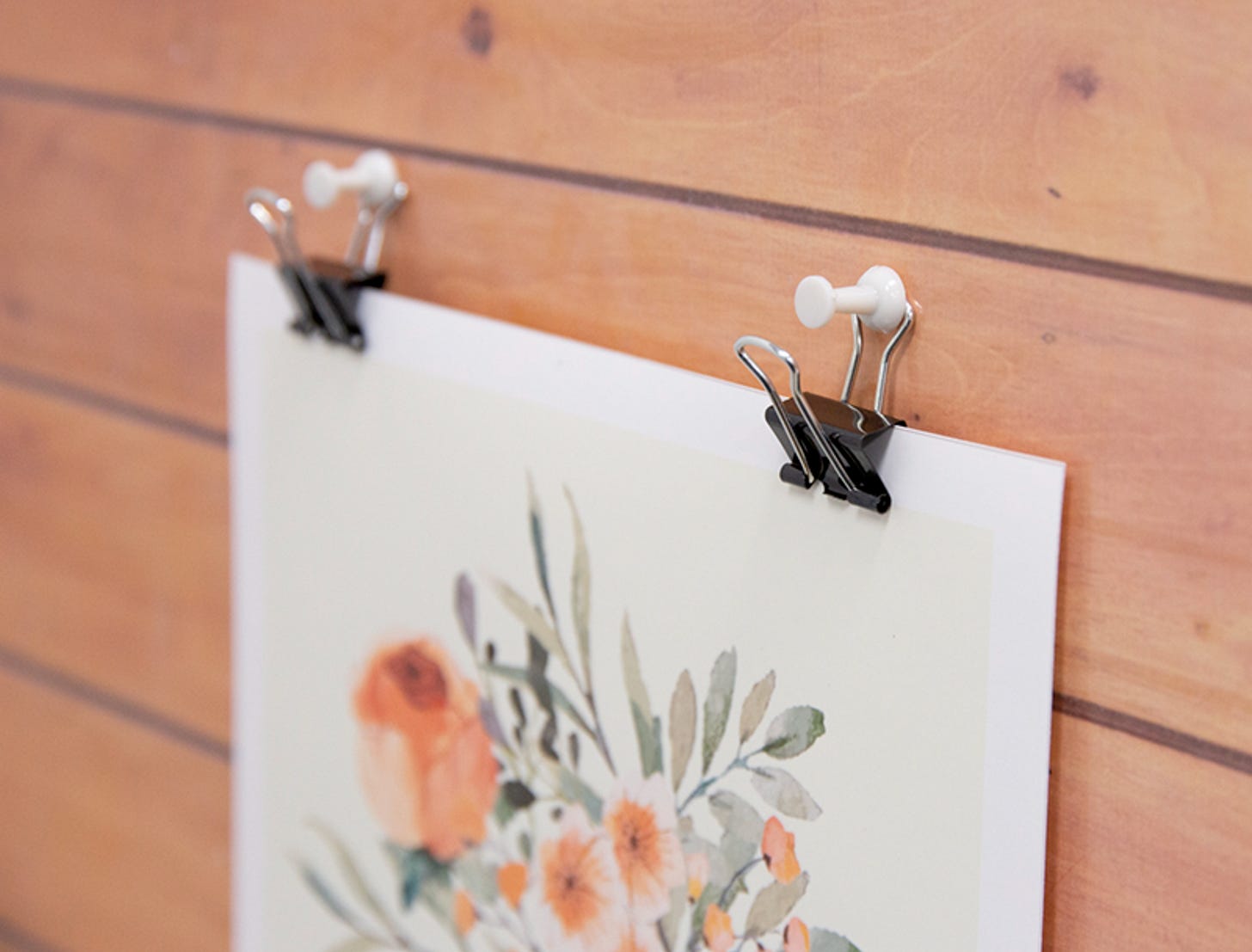The Binder Clip: An Appreciation
Seriously, is there anything this brilliant piece of design can’t do?
Editor’s Note: This post is not paywalled and is available to all. Enjoy! — Paul
In my recent article about the Ephemera Fair, I mentioned that I purchased a vintage Milton Bradley construction paper sample catalog and displayed it in my home like so:
But did you notice how I mounted the catalog on the wall of that display? Let’s zoom in for a closer look:
That’s right — I used a binder clip.
This is far from the first time that I’ve reached for a binder clip to solve a particular problem, and that got me thinking that this classically inconspicuous yet endlessly versatile item deserves its own showcase. Frankly, I’m a bit ashamed not to have written about it until now.
Why are binder clips so satisfying? For starters, they’re very aesthetically appealing. The black-and-chrome color scheme1, the metallic sheen, the sharp angles at the top of the jaws tempered by the gentle curvature of the spine and the smooth curlicues at the base of the jaws — it all feels Just Right.
In addition, a binder clip delivers a very rewarding set of tangible pleasures. When you squeeze the handles to open the clip, your fingertips fit naturally into the handles’ rounded openings — a brilliantly simple piece of ergonomic design. As you squeeze, the metal jaws push back with enough resistance to reassure you that the clip is strong, but not so much that you have to struggle with it. And after the clip has been deployed, is there anything better than flipping down the handles and feeling them snap shut with that familiar thwap? I think not! In case you haven’t had the pleasure of enjoying that experience lately, here’s a reminder:
Why does the handle snap down like that? Is the action driven by a hidden spring mechanism? Nope. It’s because each of the two little cylindrical sockets that hold the ends of the handle is equipped with a little tooth or spike, as seen here:
So when you pull the handle forward, it meets resistance and slightly compresses inward as it approaches those teeth. Then, as it passes the teeth, the tension is released and the handle snaps the rest of the way forward. Here’s a close-up video that shows the process:
The same process results in a similar snapping effect if you push the handle back up (although the effect is slightly less satisfying when the handle goes in that direction). And whether the handle is positioned up or down, those little teeth keep it secured in place, so it doesn’t flop around all willy-nilly. And to think that all this design ingenuity is available to us for mere pennies apiece!
Binder clips are so ubiquitous that it feels like they just evolved naturally millennia ago, like opposable thumbs. But they were actually invented in 1910 by a gent named Louis E. Baltzley, who was trying to devise a way for his father to organize his various papers and notes.
Baltzley applied for a patent in 1910. It was granted in 1915 — an unusually long gap between application and approval. Perhaps the patent authorities were so awestruck by the magnificence of Baltzley’s creation that it took them a few years to recover their faculties. Here are the relevant patent illustrations, showing that the familiar design emerged from Baltzley’s mind fully formed, like Athena springing forth from Zeus’s head:
If you look at Fig. 3, you can see that the upper clip includes four little prongs along the saddle. These prongs held a little index card that the user could inscribe to label the papers being bound, much like the title on the spine of a book. Baltzley’s patent application explained this feature like so:
It is important to provide an index or title card for each binder clip. […] My preferable form [of achieving this] is to stamp up the card-holding fingers from the metal of the clip. […] By cutting the index cards slightly wider than the distance between adjacent fingers, sufficient retaining grip is secured to hold the card firmly in position without further device.
Early binder clips had Baltzley’s initials, “L.E.B.,” stamped into the metal of the clip and also printed at the base of the little spine cards, as you can see in this old print ad:

I like how the ad says that the title card on the spine allows the clip to “instantly make a book of any papers.”
Here’s another early ad showing the same feature, but in this case the ad text says, “Comes in two styles — with Label for filing, or plain”:
The title cards apparently never caught on and the version with little prongs was eventually discontinued. Unfortunately, I haven’t been able to determine exactly when that happened, nor have I been able to locate an early binder clip specimen that includes the prongs. Anyone know more?
While the binder clip may not have turned out to be a good substitute for a book spine, it nonetheless has lots of other uses that go far beyond Baltzley’s original goal of “temporarily and securely fastening several sheets of loose paper and the like.” The most obvious of these is hanging unframed art, which lets you avoid putting holes in the artwork and also lends a appealing light-industrial air to the proceedings.
I’ve also found that binder clips work extremely well as support stands for displaying small objects. For example, if you happen to collect vintage matchbooks, you can stand them up against a series of binder clips.
And if you’ve ever been on a Zoom call with your smartphone, you may have discovered that you can use binder clips to create a simple but effective phone stand:

And that’s just Binder Clips 101. If you want to go further, binder clips can also be used to roll up a toothpaste tube, create a bottle pyramid in your fridge, keep computer cables organized, and even create a makeshift gun. In fact, if you search YouTube for “binder clip life hacks,” you’ll find more uses for this unassuming object than you ever imagined. It seems like there’s almost nothing the binder clip can’t do (except maybe keep me from cringing when I hear the term “life hacks”).
Some quick binder clip fun facts:
Binder clips range from really small to really large.
Several fashion designers have created binder clip handbags (plus you can even make your own).

You might think that there’s no way for binder clips, with their sharp-angled edges and protruding handles, to be shaped into a ball. And yet:
I think the most amazing thing about these spherical creations is not so much the sculptures themselves, but rather that some people out there felt the need to create a sphere out of binder clips. It’s almost as if this product’s iconicity, geometricity, ubiquity, and versatility serve as a challenge for people to use it in increasingly creative and unlikely ways.
While the binder clip was Louis Baltzley’s first invention, it would not be his last. He went on to patent dozens of additional items, including a cherry pitter, a table tennis paddle, a cup holder, and a traffic signal designed to be positioned in the middle of an intersection (much like the famous dummy light in Beacon, New York). Despite venturing off in these other creative directions, he frequently returned to his original mission of keeping papers and notes organized, at one point inventing a clipboard and soon after that a newfangled paper clip.
While all of these creations had some merit, none could match the binder clip’s simplicity, elegance, or staying power, so Baltzley’s creative arc feels a bit like a case study in diminishing returns. That’s the problem with achieving Perfection on your first attempt: It’s all downhill from there. I’ve always thought this is why Charles Brannock never invented anything else after creating the Brannock Device. He knew enough to quit while he was ahead.
Paul Lukas has been obsessing over the inconspicuous for most of his life, and has been writing about those obsessions for more than 30 years. You can contact him here.
Yes, I know there are other colors available, but I tend to view them as bastard stepchildren. A true binder clip should be black and chrome, period.












Peak IC. I use these things for EVERYTHING. Without going into detail, because it doesn't matter to get the point across, I used a binder clip in two different applications to re-ink a self-inking stamp pad just this morning. These things are that versatile.
Just looking at my desk, I have one holding a bag of candy closed, a few managing computer cables, and a handful holding mismatched stackable letter trays together (think "inbox" on a desk that you stack). I also quite often use them as a form of fidget toy by clipping two of them together, which I never really thought of doing so until I read this article.
I LOVE binder clips! Thank you for this excellent article about them. I knew nothing about their invention before, so now I know whom to thank for their creation. Thanks to you, too, for giving me new ideas about how to use them. I already use them to hang up calendars and to keep my toothpaste tube tidy and to keep my cereal package closed, but you've opened up a new binder clip world for me! I partiularly like your idea of using them as tiny stands for tiny works of art. My sisters know of my love of binder clips, so I will often find binder clips in my Christmas stocking. Reading your article was a great way to start my morning.